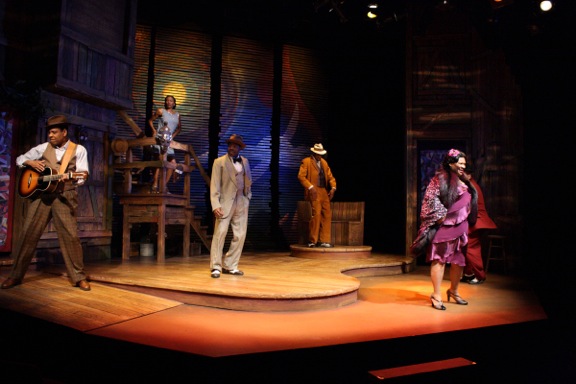As fall approaches, many theaters and scene shops are beginning to put together the list of supplies they’ll need for the coming season. Unfortunately for scenic artists, drama teachers and technical directors around the world, this is also the season for the time-honored explanation to “management” of why they need to spend the extra money on scenic paint instead of less-expensive alternatives found at the big orange store across town. Angelique Powers is the Charge Scenic at the historic Penumbra Theatre in St. Paul, MN. Like every arts organization, Penumbra is always searching for ways to do more with less. So, Angelique is familiar with working under heavily scrutinized budgets. She shared a recent experience with us that demonstrates the vibrancy of Rosco Scenic Paints (even when they’re heavily diluted) and an example of how the inexpensive paint from the hardware store didn’t live up to her scenic expectations.
I am often asked “why can’t you use cheaper ‘House Paints’ for painting sets?” I admit, sometimes I can, but for most shows it’s just not the right product – usually because I can’t always get the color punch I want. I’ve also found that if I need to work with the paint super thin, house paint can actually cause more headaches, and worse – more labor hours - to fix than if I had used scenic paints to begin with. A great example of this problem presented itself on a show I recently painted at Penumbra Theatre.
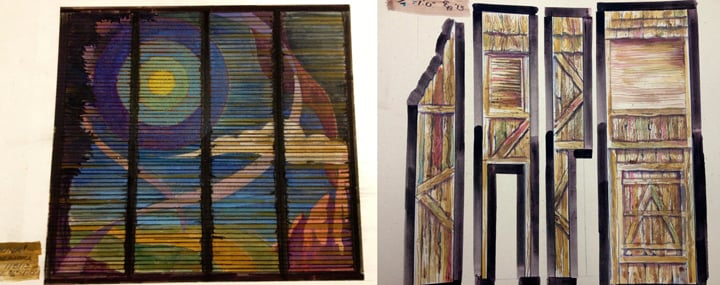
Renderings for Penumbra Theatre’s “SPUNK” – Designed by C. Lance Brockman
When presented with the design for “SPUNK,” my main directive was to use a lot of color, but not to over-saturate the wood and lose all of its great character, texture, and natural wood grain. To fulfill that directive, I chose various Rosco Supersats & Off Broadways because I knew that, even after I diluted them heavily with water, they would deliver just what I needed: a huge amount of color impact that would allow the natural character of the wood to shine through. More importantly, by watering the paints down I could make them fit into my ever-scrutinized paint and labor budget.
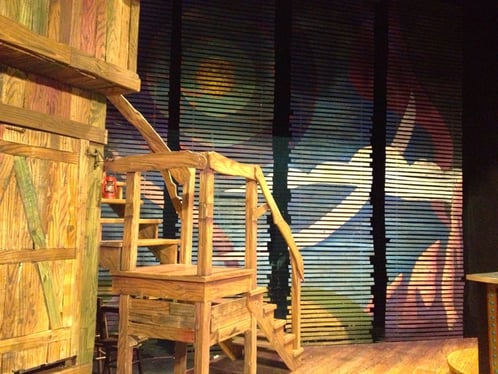
Vibrant Colors on the upstage mural thanks to Rosco Supersaturated Paints
The upstage mural was created from steel frames and lathe wood strips. We laid foam underneath so that I could walk on it to paint. I back painted and based everything using very thinned Supersaturated Velour Black - it gave me a great base to work with and I didn't have to worry about "paint holidays" as I did my color work.
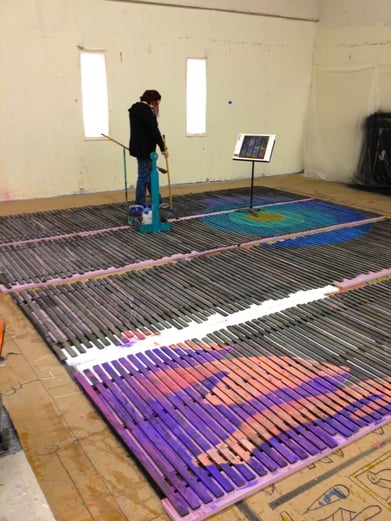
Angelique painting the upstage mural.
All of the colors were Rosco Supersats, and I used very little actual paint – sometimes only a couple of tablespoons that I thinned to the consistency of skim milk. The Supersats gave me the ability to do some subtle blends that still had a huge impact.
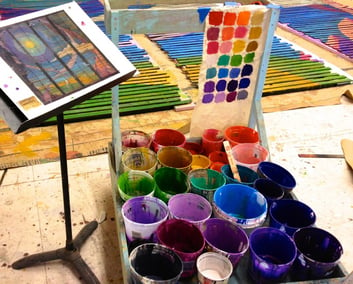
Angelique’s palette of diluted Supersaturated paints produced the vibrant colors she needed.
The walls for the set were faced with wood from shipping pallets, so a lot of the hard work was done for me. All I needed to do was tone the wood planks and add additional accent colors and graining.
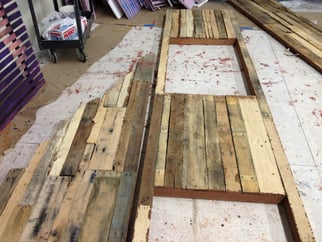
The raw wood walls before their color-wash & wood-grain accents.
I began with 3/4 gallon each of Rosco Off Broadway Raw Sienna and Earth Umber and, after mixing and diluting with water, created about 7 gallons of various browns that I used on everything from the walls to the floor. Once my base-coat of beiges and browns had dried, I used some of the left over paints from the upstage mural (that I thinned with water even more) to add the accent color washes to the wood walls.
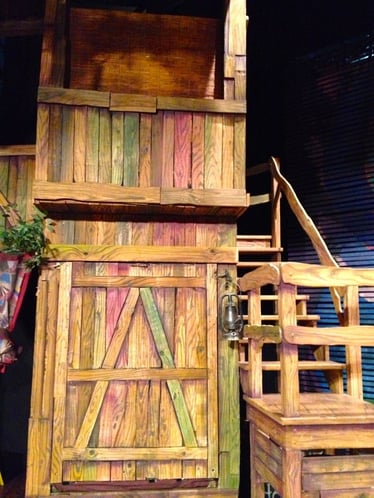
The finished, color-washed walls.
After the color dried, we added shadows, cut lines and cartooned a wood grain effect into the scenery using Supersaturated Payne’s Grey thinned to a 1:20 ratio. It was a very cool effect that accentuated the wood’s natural features and gave the set a great sense of character on stage.
As you can tell, I maximized my scenic paint budget by diluting my paints heavily with water. This also included the brown paint that I used to back paint the walls (I chose brown so that when it dripped through the slats, the back paint wouldn’t ruin things on the front). I chose to use traditional house paint for this back painting project. To speed up the process, and to help me cover all of the nooks and crannies, I decided to use a hudson sprayer to apply the back paint. It was a huge time saver, and yes we saved money by using paint from the paint store down the street. However, here is where the house paint failed me. The watered-down, brown paint ended up turning into green puddles because the tints in the house paint went all haywire and separated themselves when I added the amount of water I needed.
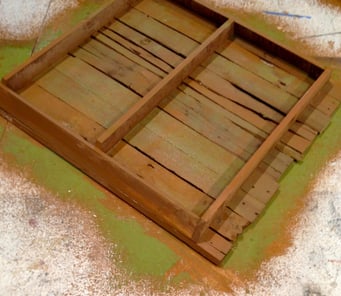
This is supposed to be brown – not green.
Thank goodness this was the back painting! If this had happened to the front my scenery, I would have cried. Plus, it would have cost the production much more to buy the proper paints and pay the labor to correct it than it would have to use the proper scenic paint in the first place. I have seen house paint perform this way in the past, which is one of the many reasons I choose scenic paint like Rosco Off Broadway and Supersaturated for creating my scenery.

A stage shot of the "Color Punch" Angelique created for Penumbra Theatre's "Spunk"
“SPUNK” - Penumbra Theatre
Scenic Designer: C. Lance Brockman
Scenic Charge: Angelique Powers
Lead Scenic: Molly Kern
Photo Credit: Allen Weeks
Save

